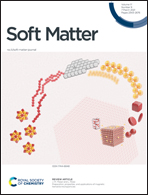Wetting of a solid surface by active matter
Abstract
A lattice model is used to study repulsive active particles at a planar surface. A rejection-free Kinetic Monte Carlo method is employed to characterize the wetting behaviour. The model predicts a motility-induced phase separation of active particles, and the bulk coexistence of dense liquid-like and dilute vapour-like steady states is determined. An “ensemble”, with a varying number of particles, analogous to a grand canonical ensemble in equilibrium, is introduced. The formation and growth of the liquid film between the solid surface and the vapour phase is investigated. At constant activity, as the system is brought towards coexistence from the vapour side, the thickness of the adsorbed film exhibits a divergent behaviour regardless of the activity. This suggests a complete wetting scenario along the full coexistence curve.



 Please wait while we load your content...
Please wait while we load your content...